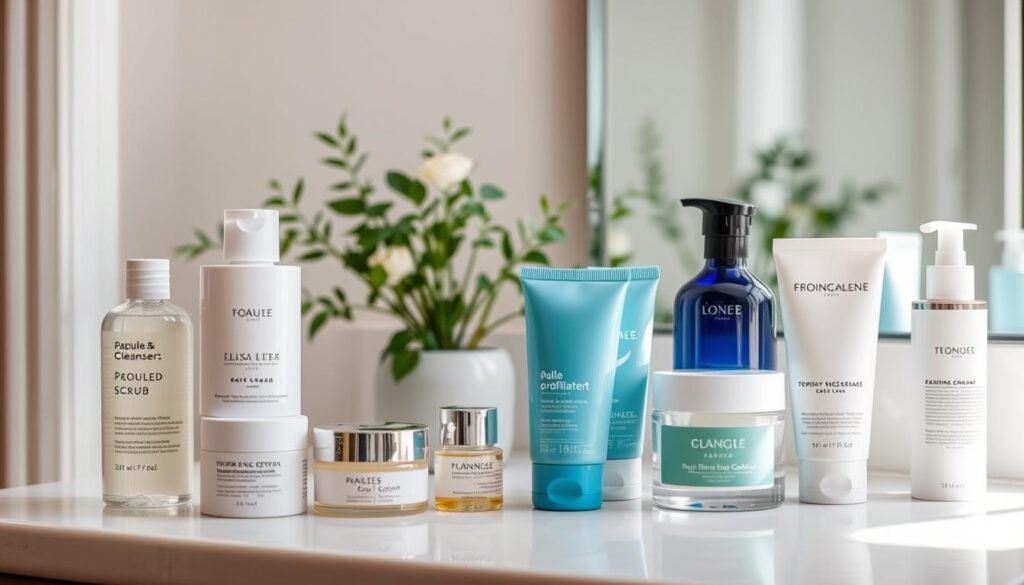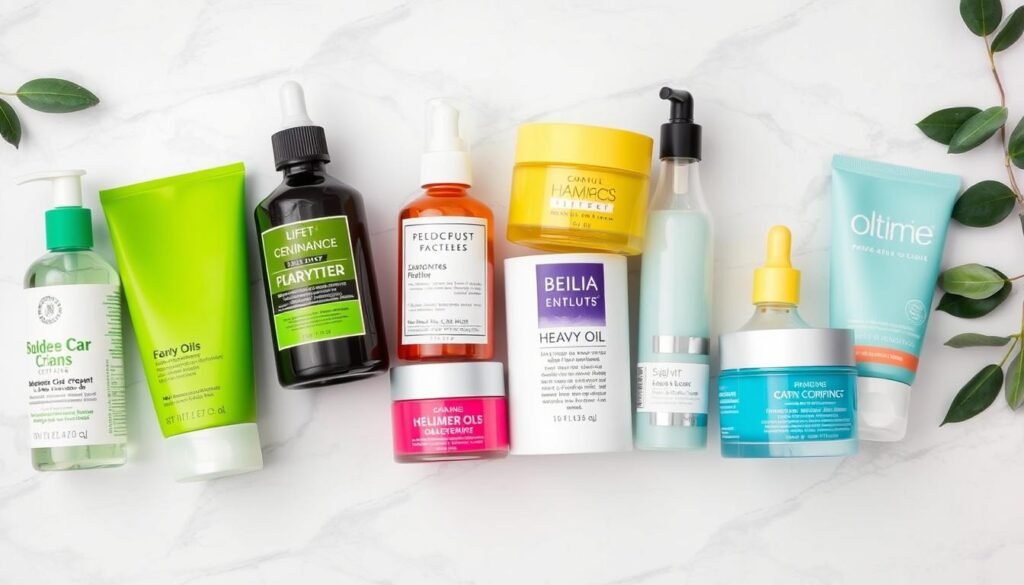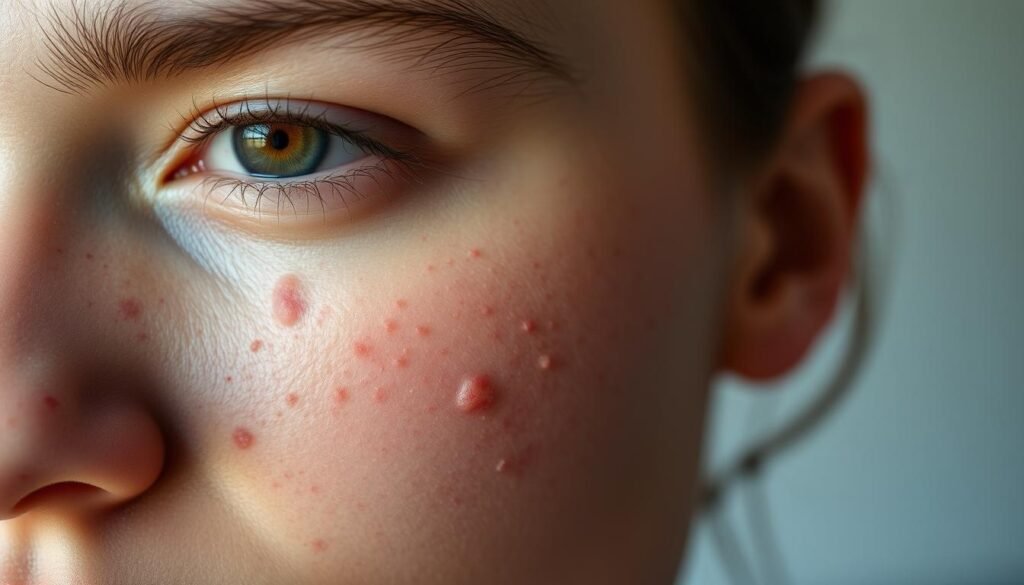Did you know over 85% of people face acne at some point? Papules acne is one common type. It shows up as small, red, raised bumps. These blemishes are part of acne vulgaris and affect many. Papules signal a deeper issue with oil production and hormonal changes, unlike simpler acne types like blackheads or whiteheads.
It’s vital to understand these acne signs, causes, and how to treat them. This knowledge helps in managing the condition and getting clearer skin. This article digs into papules; what they are, their causes, and various ways to solve this issue.
Key Takeaways
- Papules are inflamed, red bumps that can develop into pustules.
- They typically heal within weeks, while more severe forms take longer.
- Common causes include excess oil, bacterial growth, and hormonal fluctuations.
- Effective treatments range from over-the-counter products to dermatologist interventions.
- A consistent skincare routine and lifestyle adjustments can help prevent papules.
What Are Papules in Acne?
Papules are a common type of acne, showing up as small, inflamed spots on the skin. Knowing what they are can help people deal with them better.
Definition of Papules
Papules are small, red bumps that appear on the skin. They don’t have a pus-filled center like some spots do. They are usually less than 5 millimeters wide.
Their growth is often caused by clogged pores. This happens from too much oil and bacteria on the skin.
Characteristics of Papules
Papules have traits that make them different from other acne types. These traits include:
- Firmness: They are solid when you touch them.
- Tenderness: They might hurt if you press on them.
- Coloration: They often look red, showing they are inflamed.
Papules form because of blocked pores. If bacteria infects them, they can turn into pustules. It’s important to recognize their features to treat and prevent more skin issues.
Causes of Papules Acne
Papules acne starts from a few main reasons. Too much oil is a big cause. Knowing how these reasons connect helps us manage this skin issue better.
Excess Oil Production and Clogging Pores
Too much oil leads to sebum build-up in hair follicles. This situation is perfect for getting acne vulgaris. When oil meets dead skin, it blocks pores. This blockage then creates comedones, setting the stage for papules to appear on the skin.
Bacterial Growth: The Role of P. acnes
The mix of too much oil and dead skin helps bacteria grow. This is particularly true for Propionibacterium acnes (P. acnes). This bacteria loves to live in clogged pores. It causes swelling and the red look of papules. Learning about this bacteria shows why we need the right treatments.
Influence of Hormonal Changes
Hormone changes, like during puberty or menstrual cycles, boost oil production. Androgens make sebaceous glands more active. This means more oil and a higher chance of getting papules. Stress and eating habits can also make hormone effects worse.
| Factor | Description |
|---|---|
| Excess Oil Production | Leads to clogged pores and the formation of comedones. |
| Bacterial Growth | Propionibacterium acnes proliferates in blocked pores, causing inflammation. |
| Hormonal Changes | Fluctuations increase oil production and trigger acne flare-ups. |
Differences Between Papules and Other Types of Acne
Understanding the different types of acne is key to finding the best treatment. Each acne type has special traits. These traits shape how we treat it. Let’s look closely at papules, as well as pustules and cystic lesions.
Pustules vs. Papules
Papules and pustules are both types of inflammatory acne, but they’re not the same. Papules acne appears as small, red, and sore bumps. On the other hand, pustules also have a white or yellow tip filled with pus. This pus makes pustules stand out more, urging people to get help sooner.
Nodules and Cystic Lesions
Nodules are a tougher form of acne than papules. They form deep in the skin, causing a lot of pain and swelling. Cystic lesions are even more severe. They fill with lots of pus, are very painful, and can scar if not treated. Knowing these differences highlights why it’s crucial to treat severe acne quickly, to avoid permanent skin damage.
Non-Inflammatory Acne: Blackheads and Whiteheads
Unlike inflammatory acne, blackheads and whiteheads don’t get red or swollen. Blackheads, or open comedones, have a dark color because the follicle is open but clogged. Whiteheads are closed comedones, turning into small, flesh-colored bumps. Even though they’re less severe, treating them consistently is necessary. This helps stop them from turning into more serious types of acne.
To learn more about handling different acne types, check out this resource. It offers insights into myths, causes, and effective skincare routines. Understanding these differences is key to creating treatment plans. These plans help fight acne and lead to clearer skin.
How Papules Form
Papules acne happens when pores get blocked and inflamed. Knowing how this works helps us prevent and treat it better.
The Process of Follicle Blockage
Papules start with hair follicles getting clogged. This is due to too much oil, dead skin, and bacteria. These blockages, called comedos, can lead to worse acne. When pores are blocked, they swell. The trapped bacteria make the situation more serious. This often shows as red, raised bumps on the skin, especially noticeable on lighter tones.
The Role of Inflammation
Inflammation kicks in after the blockage. The immune system fights the bacteria, causing redness, swelling, and pain. This is how papules look. Unfortunately, this immune response can make papules worse. It may need special treatment. Using treatments like benzoyl peroxide and salicylic acid can help. Good skincare and lifestyle changes are also key.
Symptoms Associated with Papules Acne
Papules acne shows up as small, red bumps on the skin. They can be spots or bigger blemishes. People with papules often feel self-aware and worry about their looks.
These bumps can be sore when touched. This might make someone want to scratch or touch them. But, that can make things worse, leading to more skin issues.
Physical Appearance of Papules
These red, swollen bumps appear without warning. They look different and can be confused with other skin problems. This causes concern and embarrassment for many.
The bumps are tender and can hurt, which is uncomfortable. Tinkering with them aggravates the condition, increasing irritation.
Common Discomforts and Pain
Papules not only look bad but also feel painful. The pain ranges from a slight irritant to severe aches. Because of the pain and itchiness, one becomes more aware of their skin.
This attention can be upsetting, leading to more touching. But everyone’s experience varies. Most aim for relief, to feel better mentally. Studies show these symptoms lower life quality. Thus, it’s crucial to find good treatments. For more info, check out papules acne management.
Treatment Options for Papules Acne
Starting with over-the-counter treatments is effective for papules acne. They manage symptoms well. Many topical treatments reduce inflammation and stop new lesions from forming.
Over-the-Counter Treatments
Common options include:
- Benzoyl peroxide – it targets acne-causing bacteria.
- Salicylic acid – exfoliates and unclogs pores, reducing inflammation.
- Adapalene – a retinoid preventing clogged pores.
These are the first defense against mild to moderate acne. They often show improvements over time.
Prescription Medications and Dermatological Treatments
If basic treatments don’t work, a dermatologist may recommend prescriptions. Options include:
- Topical retinoids like tretinoin or tazarotene. They reduce inflammation.
- Oral antibiotics for severe cases.
- Hormonal treatments, like birth control for women, balance hormones.
Combining treatments is more effective than using just one.
Role of Home Remedies and Lifestyle Changes
Lifestyle changes and home remedies are significant in acne management. Some tips are:
- Eat a diet rich in antioxidants and low in sugar.
- Keep the skin clean to avoid oil buildup.
- Reduce stress with yoga or meditation.
These practices help prevent new breakouts and manage existing acne, leading to healthier skin.

Preventative Measures for Papules Acne
Taking steps early can help stop papules acne before it starts. Keeping your skin healthy with a good routine is key. Adding smart habits and watching what you eat can lead to clearer skin.
Skin Care Routine Tips
Your skin care routine is super important. Choose gentle cleansers and products that don’t clog pores, made for oily or acne-prone skin. Here are more tips to boost your routine:
- Cleanse twice daily to remove excess oil and debris.
- Incorporate exfoliating agents like salicylic acid to unclog pores.
- Moisturize with lightweight products to keep the skin hydrated.
- Use sunscreen daily to protect against UV damage.
Dietary Considerations and Stress Management
What you eat affects your skin. Eating less sugar and more foods rich in antioxidants and omega-3s can reduce inflammation from papules acne. Consider adding:
- Fresh fruits and vegetables for vitamins and minerals.
- Fatty fish, such as salmon, for healthy fats.
- Nuts and seeds for additional nutrients.
Managing stress with meditation, yoga, or exercise can also improve your skin. Lower stress can mean fewer acne breakouts.
Skincare Products to Avoid for Papules Acne
People with papules acne need to be careful about their skincare products. Some ingredients can make breakouts worse or irritate sensitive skin. Here are types of products to be wary of.
Harsh Cleansers and Astringents
Many cleansers and astringents have strong chemicals that remove skin’s natural oils. This can lead to more oil production and worsen acne. They contain alcohol to balance skin but can irritate instead.
Choosing gentle cleansers that keep the skin’s moisture barrier intact is better.
Oil-based Cosmetics
Oil-based cosmetics might seem good but can block pores, causing worse acne. They often have lanolin or coconut oil, which trap dirt and sebum. It’s best to pick non-comedogenic products if you have acne-prone skin.

Consulting with a Dermatologist
Knowing when to get help for papules acne is important for your skin and feelings. You should see a dermatologist when home treatments don’t work, or the acne hurts or looks worse. A dermatologist’s help is great for ongoing or serious acne.
When to Seek Professional Help
It’s vital to know when to see a dermatologist. You should go if you have:
- Acne that stays even after trying store-bought products.
- Lesions that hurt or get bigger.
- Acne that is very inflamed and might leave scars.
- Feeling upset or stressed because of your acne.
Seeing a dermatologist can help. Visit this link for advice on getting the right help.
What to Expect During a Consultation
At a dermatologist meeting for papules acne, you’ll get a full check-up. The doctor will:
- Look at your skin and talk about your symptoms.
- Ask about what treatments you’ve tried.
- Make a care plan just for you, maybe with prescriptions or other treatments.
This approach often works better for tough acne, making sure you get the best help.
Seeing a dermatologist helps treat acne and its emotional effects. Getting professional help is key for dealing with papules acne.
Living with Papules Acne: Tips for Management
Dealing with papules acne is tough, both on your skin and your emotions. It often causes low self-esteem and anxiety. These feelings can touch every part of your life. It’s key to understand these effects to manage your acne better.
Emotional Impact of Acne
The emotional toll of papules acne is big. You might feel less confident, avoid social scenes, or feel depressed. Since papules acne is visible, it can make you hyper-aware in social spots. This makes finding emotional support crucial. Counseling can really help if your emotions are too much to handle alone.
Support Groups and Resources
Finding a support group can make you feel less alone. It’s good to talk with others who get what you’re going through. Online forums and local groups offer a place to share and get tips. They help you feel stronger emotionally. Plus, using resources like educational articles can boost your knowledge and control over acne. This can make you feel more in charge and less isolated.

Conclusion
Understanding papules acne is crucial for its effective control and care. This skin issue is common but can be tackled. Various steps can help manage acne problems well. There are many treatments available. These range from options you can buy without a prescription to meds that doctors prescribe. They aim to deal with the main causes of acne. Adding a good skincare routine can help achieve clearer and healthier skin.
Using treatments like creams that renew skin, products that kill germs, and keeping up with daily skin care are key. These steps help in dealing with papules and stopping new ones from forming. Also, paying attention to diet and how to manage stress can make skin healthier. To learn more about fighting papules acne effectively, check out this guide.
Knowing about your skin’s needs and getting advice from experts are crucial steps. They help in understanding and dealing with papules acne. Making smart choices about skincare and how you live can lead to healing. It also helps keep your skin looking and feeling healthy.